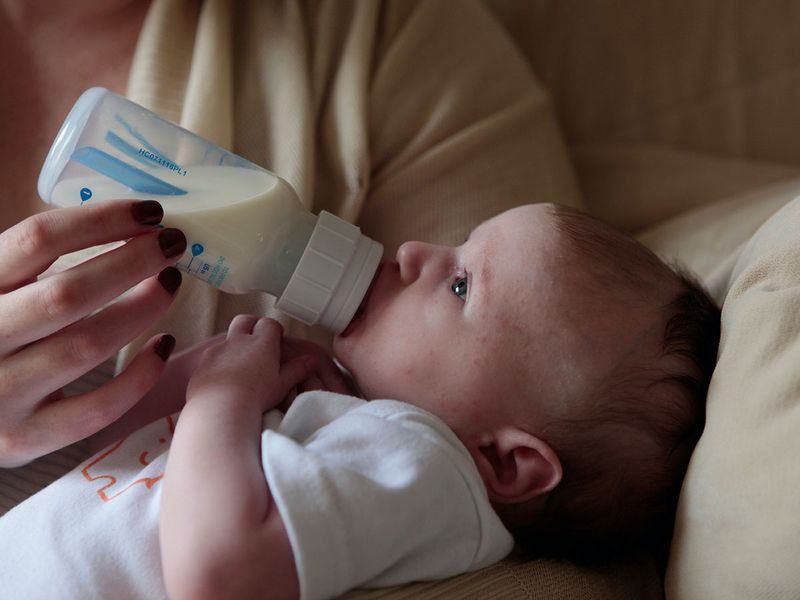
If you give your newborn water before he or she is six months old, you’d be doing them a disservice. The World Health Organisation (WHO) explains that not only would you be putting them at risk of diarrhea – the water may not be completely free of germs – but also of malnutrition. “Giving water may also cause the baby to drink less breastmilk or to stop breastfeeding early and therefore cause malnutrition,” it explains.
WHO recommends infants be breastfed exclusively for the first six months, yet there are tons of questions flitting around. When does a new mum begin to produce milk, for instance, or how does she find out if the baby is actually drinking? We asked experts in the UAE to answer some of the most common queries raised by mothers.
When does breast milk actually come in? What is the substance that breasts begin to leak before it?
Renita Suvares, Lactation Consultant at Aster Hospital, Qusais, explains that the thick yellowish or clear discharge you may see initially is called colostrum. “It is available to the baby in small, but adequate volumes. It is higher in protein and lower in fat than mature milk. Mature milk occurs 30-40 hours postpartum. The milk is thinner in consistency and white in colour,” she adds.
Dr Maryam Tarish Al Mansoori, founder of health services company Mommy & Me and emergency medicine specialist, says that colostrum supports your baby's immune system in fighting infections.

Colostrum is available to the baby in small, but adequate volumes. It is higher in protein and lower in fat than mature milk. Mature milk occurs 30 to 40 hours postpartum. The milk is thinner in consistency and white in colour.
Does the size of the breast affect the amount of the milk it yields?
No.
“Breast size is irrelevant when it comes to how much milk a mother can produce. It has long been clear that women with small breasts can make just as much milk as women with large breasts. Breasts will likely grow larger before and during a mother’s breastfeeding journey,” says Dr Shachi Joshi, Specialist Aesthetic Gynaecologist , Medcare Medical Centre – JBR.
How can I check if my baby is drinking milk or just suckling?
Doctor Joshi offers a four-step solution to this conundrum. But she’s quick to warn that "if you suspect you aren't making enough milk or your baby isn't gaining weight properly, call your doctor and a lactation consultant right away".
1. Feel it: When your baby first latches onto your breast, she will suck rapidly, which helps release the milk. Then she should progress into a deep, slow pulling motion as she swallows; you may not only feel this motion, but also see her jaw drop down and hear her as she does this.
2. Observe the baby: If your baby seems content and well fed after feeding sessions, all is likely going well.
3. Keep an eye on evacuation: She fills her diapers. Most breastfed infants wet six to 10 – and soil at least three diapers per day in the first month. Stool colour is also important: While the first bowel movements are typically black and sticky, they should be green by day three or four and yellow by day four or five. The consistency of the stools should also be seedy or watery.
4. Weight is an indicator: It's normal for your baby's weight to fluctuate in the first few weeks of life. If she has a weight loss of 10 per cent or more, there could be a problem. By day 10, your baby should rebound to her birth weight.
“The sucking during which baby drinks the milk is called nutritive sucking and suckling is called non-nutritive sucking. To know whether your baby is drinking milk or just suckling you need to check the following: The burst of nutritive sucking varies from 10 to 30 sucks during each cycle, with 1 suck per second frequency. The sucking is followed by swallowing after every 4 to 5 sucks, this can affect breathing momentarily. This is slow and deep sucking. Most of the time, once the baby’s tummy is full, the baby starts suckling,” says Prachi Omkar Shetye, Physiotherapist and Lactation Consultant at Somerset Clinic.
How can I increase milk supply – any particular foods I should be eating/avoiding?
Suvares says early initiation of breastfeeding can help with steady milk supply. Globally, says WHO, three in five children are not breastfed in the first hour of their lives; this impacts not only the health of the baby but also affects the lactating new mum. “Positioning and deep latch, frequent feeding about 8 to 12 times a day and emptying the breast after every feed helps in increasing the milk supply,” says the lactation consultant. “More stimulation using hand expression or using breast pump helps in addition.”
She also suggests keeping yourself hydrated. “Drink sufficient water, fruits like avocados and green leafy vegetables, almonds, oatmeal, fenugreek, fennel, cumin, garlic, lean meat and poultry to increase milk supply,” she says.
Omkar Shetye says caffeine for the new mum should be restricted to 200mg/day. “Caffeine is present in coffee, tea, chocolates and soft drinks. It is highest in coffee, one cup of brewed coffee can have up to 140mg." Some of the better choices are:
- Decaffeinated coffee and decaffeinated tea if you are consuming more than one cup of coffee or tea.
- Milk chocolates instead of dark chocolates as they have less caffeine content.
- Fresh fruit or other flavours of cake over chocolate cakes.
- Cream biscuits that have flavours other than chocolate.
- If possible, make changes in your daily caffeinated products in anticipation of large portions of chocolate desserts on festive occasions.”

Can I continue to feed if I have cold, flu or COVID-19?
Breastfeeding provides your baby with the best nutrition and helps fight against illness and infection, says Al Mansoori.
Suvares adds: “There is no strong evidence to show that the virus can be carried or passed on in breastmilk. The well-recognised benefits of breastfeeding and the protection it offers to babies outweigh any potential risks of the transmission of COVID-19 through breastmilk.”
If you choose to feed your baby, the following precautions are recommended:
- Wash your hands before touching your baby, breast pump or bottles
- Try to avoid coughing or sneezing on your baby while feeding at the breast or from a bottle
- Consider wearing a mask or face covering while feeding
- Follow recommendations for pump/bottle cleaning after each use
- Consider asking someone who is well to feed your expressed breast milk or formula milk to your baby
My baby has colic. Is it my fault? What can I do?
Experts explain that colic – or unexplained crying and fussiness – is not any new mum’s fault. Al Mansoori says: “One of the many reasons for colic is that your newborn’s digestive system is immature and time is all that you need. Colic usually subsides at two to four weeks of age. In case it persists longer or your baby is not feeding, experiencing decreased urine or stool output, or seems less active at times, I would advise you to visit your paediatrician for a thorough evaluation.”
Omkar Shetye explains that the causes of colic are different; some of the common causes of colic pain are: “Lack of burping, oversupply of breast milk, cow’s milk protein allergy or gastro intestinal infections.
“So it is first important to consult your paediatrician and find out what is the cause in your particular case and then according to that your lactation consultant can work on breastfeeding modifications required.”

One of the many reasons for colic is that your newborn’s digestive system is immature and time is all that you need. Colic usually subsides at two-four weeks of age. In case it persists longer or your baby is not feeding, experiencing decreased urine or stool output, or seems less active at times, I would advise you to visit your paediatrician
Suvares recommends emptying one breast completely before going for the other breast while feeding. She also says, “If your baby is exclusively breastfeeding, watch what you eat. You can talk to your doctor about temporarily avoiding foods that cause tummy issues in babies. If your baby is formula fed you can ask your paediatrician about changing the powder. Avoid over stimulation. Burping will help in relieving the pain if colic is due to gas.”
Dr Joshi adds that sometimes the swaying motion of rocking your baby in your arms can help. She also suggests a warm bath followed by a gentle tummy massage. “Create a calming atmosphere. Babies can become overstimulated with lots of noise and activity around them. Try to quieten your surroundings, switch the TV off, dim the lights, and try to take some deep breaths yourself,” she says.
How can I keep my nipples from hurting/bleeding?
Dr Joshi says the one thing that can make a world of difference is whether your baby is latching on correctly. “They can also check your baby for problems with their lips and tongue and whether you have medical problems like dermatitis or nipple infection. If you use a nipple shield, make sure it is the correct size and if you’re using a breast pump, make sure you’re doing it properly. Wash your nipples with water after every feed and clean and sterilise your nipple shield after each feed.

If you can, continue breastfeeding (it is quite safe for baby to feed on a bleeding nipple). But if it’s too painful, you may need to take your baby off the breast for 24 to 48 hours, rest the nipple and feed your baby expressed breast milk. Gradually reintroduce the breast.
“If you can, continue breastfeeding (it is quite safe for baby to feed on a bleeding nipple). But if it’s too painful, you may need to take your baby off the breast for 24 to 48 hours, rest the nipple and feed your baby expressed breast milk. Gradually reintroduce the breast after resting for a short time and take special care with positioning and attachment,” she says.
Are painful lumps in the breast normal?
Sometimes lumps are normal. Plugged milk ducts, engorged breasts, and mastitis are a few of the possibilities, and all can present as a breast lump, explains Dr Joshi.
Suvares says: “Sometimes while breastfeeding if the portion of the breast not getting emptied completely the milk duct may get blocked and you may notice a small lump, size of a pea in your breast. This could be painful. Apply a warm compress to the area before starting the feed. Massage the breast and move the lump towards the nipple. Position your baby’s nose or chin towards the lump, this helps the milk duct to open.”
However sometimes they are a symptom of something else. Omkar Shetye says: “Painful lumps in the breast are not normal and the mother should consult her doctor and get it checked. She can continue to breastfeed from breasts, as frequent drainage of milk can avoid worsening of the situation.”
If my baby is not drinking milk, what can I do?
Suvares says if the baby isn’t drinking milk because of grogginess, try to walk the baby up; skin to skin contact may help here.
Omkar Shetye concurs. She offers some practical tips:
- Change your breastfeeding position, make sure you and your baby are properly supported and comfortable.
- In the first few days, a cross-cradle hold is helpful for moms as the neck is properly supported.
- It is also possible that the baby is not able to latch well if your breast is too full, so hand express a few drops of milk and then put the baby at breast.
- Skin to skin [contact] can be done to encourage latching
- Refrain from using pacifiers or bottles in the first 4 to 6 weeks till breastfeeding is well established to avoid nipple confusion.
- If you are using a bottle then use a slow flow nipple.
Al Mansoori warns that a baby might be refusing to breastfeed due to lots of reasons, illness, nipple confusion, decreased milk supply and much more. She suggests seeing a consultant to resolve the issue before giving up on breastfeeding. But even if you can’t there are alternatives, which include providing expressed milk by syringe, cup, or bottle.



